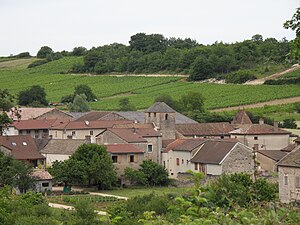Bissy-la-Mâconnaise
| Bissy-la-Mâconnaise | ||
|---|---|---|
|
|
||
| region | Bourgogne-Franche-Comté | |
| Department | Saône-et-Loire | |
| Arrondissement | Mâcon | |
| Canton | Hurigny | |
| Community association | Mâconnais Tournugeois | |
| Coordinates | 46 ° 29 ′ N , 4 ° 47 ′ E | |
| height | 243-530 m | |
| surface | 4.96 km 2 | |
| Residents | 205 (January 1, 2017) | |
| Population density | 41 inhabitants / km 2 | |
| Post Code | 71260 | |
| INSEE code | 71035 | |

|
||
Bissy-la-Mâconnaise is a French commune in the region of Bourgogne Franche-Comté in Saône-et-Loire . It belongs to the canton of Hurigny in the Mâcon arrondissement .
geography
The small town with 205 inhabitants (as of January 1, 2017) is located in the Haut-Mâconnais on the route départementale D 58 immediately after Lugny in the direction of Tournus, 20 km northwest of Mâcon . The hamlet of Charcuble , located at the foot of Mont Saint-Romain , is also part of the municipality .
history
At the time of feudalism , Bissy-la-Mâconnaise was a bailiwick belonging to the diocese of Mâcon. Under canon law, the bailiff was subordinate to the archpriest of Vérizet (today Viré ), whereas the case law was carried out by the Baron von Lugny.
In order to weaken the last entrenched supporters of the league , King Henry IV had numerous castles razed in the area after the subjugation of the Mâconnais in 1594, including the fortified castle of Bissy.
Toponyms
Bissiaci , Bissiaci Matisconensis , Bissiaci Matiscon , Bissie , Bissy.
Population development
| year | 1962 | 1968 | 1975 | 1982 | 1990 | 1999 | 2008 |
|---|---|---|---|---|---|---|---|
| Residents | 155 | 165 | 149 | 151 | 158 | 177 | 197 |
Viticulture
The wines produced in the village (mainly white wines) can be marketed under the designation of origin ( Appellation d'Origine Contrôlée ) Mâcon AOC . In addition, the Burgundy wines Aligoté , Bourgogne Grand Ordinaire , Crémant de Bourgogne and Passetoutgrain, which are widely distributed in the region, can be grown in Bissy-la-Mâconnaise .
Attractions
lock
Only the remains of the tower are left of the fortified castle from the mid-14th century. It was fought over between the parties during the Huguenot Wars , was conquered and soon recaptured. The last lord of the castle was Georges de Bauffremont , Count of Cruzille. In 1593 he wanted to hand it over to the natural owner Jean de Saulx , Baron von Lugny, in exchange with the castle in Dulphey (former hamlet near Tournus ), but this trade became obsolete the following year when Henry IV had both castles razed .
church
The Église Saint-Cyr-et-Sainte-Julitte is dedicated to the two 4th century Saints Quiricus and Julitta . The client for the late Romanesque building from the 12th century was the Abbey of Cluny . The massive construction and the tower with the Massif barlong are reminiscent of a donjon . The layout of the church is simple: a nave extended by a short yoke which carries the tower ( Travée sous clocher ), subsequently the portal with pre- porch . The other end of the nave opens into an apse with a hemispherical vault ( cul-de-four ). A stair tower is built on the right side of the church, which has been a listed building since 1961 . The spiral staircase inside the tower is adorned with colored statuettes that are an important testimony to folk art of the 18th century.
Chapel in Charcuble
In the hamlet of Charcuble is the small chapel Chapelle de Charcuble , which was built by the Chantiers de la jeunesse française (CJF Section Vauban) on May 1, 1941 in less than twenty-four hours. Between 1940 and 1944, the CFJ were an officially non-denominational (but in fact led by people closely related to the Catholic Church) paramilitary organization with youth training camps. The organization has a dubious reputation for having been instrumentalized one after the other by both the Vichy regime and the Resistance . The young people dedicated the chapel to Saint Philippe , who has name day on May 1st, and to Joan of Arc . Every year on May 1st a meeting and a Holy Mass take place on site.
Individual evidence
- ↑ Entry no. PA00113116 in the Base Mérimée of the French Ministry of Culture (French)
- ↑ Heiner Timmermann: Coping with the Past in Europe in the 20th Century , Vol. 1, p. 138f. Lis Verlag, Münster, 2010.
- ^ Maurice Larkin: Religion, Politics and Preferment in France Since 1890 , pp. 179f. Cambridge University Press , 1995.



